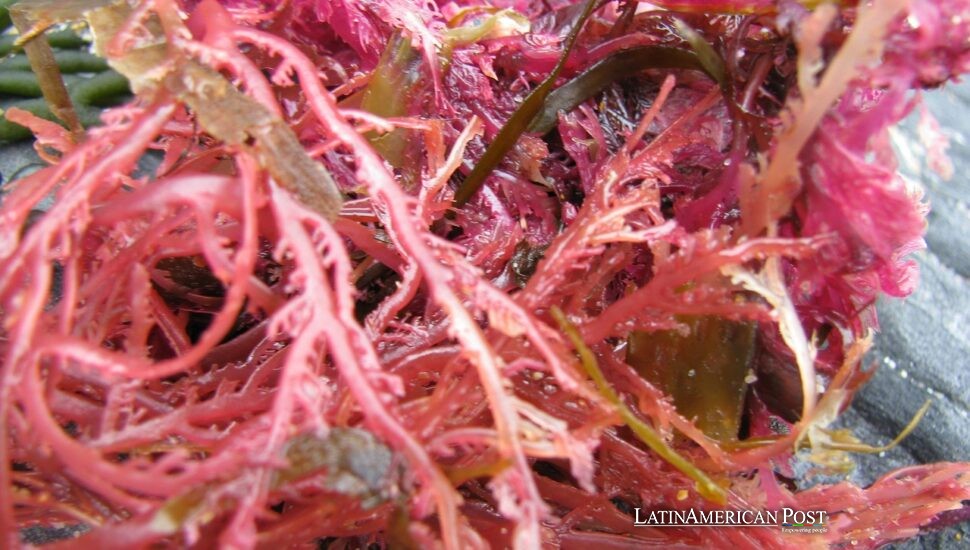Uruguay Takes Bold Steps Against Harmful Red Tide

Uruguay enforces strict bans on shellfish to protect public health and preserve marine ecosystems.
Uruguay’s Commitment to Marine Safety
Boldly acting to keep people healthy and shield ocean habitats, the Uruguayan government stops the taking selling and moving of mussels, clams and cockles in coastal areas Maldonado and Rocha. This ban ‒ created because of a dangerous algal bloom called red tide ‒ shows Uruguay’s active steps in caring for nature and safe food practices. The Ministry of Livestock, Agriculture, and Fisheries issued the directive following the detection of lipophilic toxins in bivalve mollusks harvested from these key coastal regions, which are also major tourist destinations during the summer season.
Red tide events happen when certain algae ‒ like Alexandrium species ‒ grow a lot. These algae create strong toxins that pile up in shellfish. People who eat these tainted shellfish face very serious health risks, e.g. paralytic shellfish poisoning (PSP). Cooking does not kill these toxins, so stopping them is very important. In Uruguay’s case, the presence of lipophilic toxins in mussels, clams, and cockles collected from Maldonado and Rocha triggered the immediate ban to prevent potential health hazards.
Maldonado and Rocha are renowned for their beautiful beaches and vibrant tourism industry, attracting thousands of visitors each year. When many tourists visit during certain times, the local economy grows a lot ‒ seafood plays an important role in what people eat there. But finding red tide toxins creates big problems for people’s health and the jobs of those working with shellfish. Acting quickly the government tries to reduce these dangers and keep Uruguay known for very good seafood.
Economic and Social Impacts of the Ban
The stop on taking selling and moving shellfish in Maldonado and Rocha brings big money and social problems. These seaside areas are very important spots for Uruguay’s seafood business ‒ helping many fishermen, workers and sellers. The stop hits these people’s jobs hard ‒ maybe causing big money troubles. Fishermen who rely on catching shellfish often might face times without work or less pay until the red tide goes away ‒ and the stop ends.
Also ‒ the tourism business that grows with the area’s tasty seafood might see fewer visitors as eateries change their menus. People wanting fresh shellfish meals could feel let down ‒ possibly affecting how happy tourists are and if they come back later. To lessen these issues ‒ the government and local shops probably need to look at other seafood choices ‒ and use marketing tricks to keep tourists interested.
Socially ‒ the stop shows how nature’s health links with people’s happiness. Catching shellfish is not just a job ‒ it’s also a cultural habit in many seaside towns. Stopping this breaks traditions ‒ needing help groups to assist people during this time without work. Talking with locals openly from leaders is key so everyone understands why it happens ‒ and works together with the rules.
Government Response and Future Measures
To tackle the red tide problem, Uruguay’s government has planned detailed actions to handle and watch the situation closely. First ‒ no shellfish catching selling or moving around. This stops health dangers right away. The Ministry of Livestock Agriculture and Fisheries checks shellfish samples a lot to see toxin levels all the time. This checking keeps going so that when it’s safe ‒ based on facts ‒ the ban lifts.
To help people affected ‒ the government probably gives money help and offers new job resources. Training for eco friendly fishing and finding new income ways might ease money problems from the ban. Plus ‒ putting money into research aims to make Uruguay better at predicting future red tides ‒ keeping things smooth and safe for health and economy.
Telling people about red tide risks is very important now. Sharing info on why following rules matters helps avoid eating bad shellfish by mistake. Working with local news community heads ‒ and tourism folks spreads true info fast.
Red tide links to things like water heat ‒ and ocean flow changes in Uruguay’s unique shores make good spots for algae growths happen more often because climate change shifts sea temps ‒ and brings stronger storms that help harmful algae spread.
Extra nutrients from farming or city areas add fuel to red tides by giving too much food for algae growths. Fixing these issues means using smart farming methods ‒ better cleaning dirty water ‒ and cutting pollution ‒ all key steps against harmful blooms.
Uruguay shows care for nature through active moves against red tides by funding studies ‒ and tracking plus green habits ‒ they aim to keep seas healthy ‒ for coastal folks’ safety and wealth too! Teaming up with other countries facing similar problems probably helps Uruguay fight red tides better together!
Lessons from Regional Experiences
Uruguay faces red tide challenges too ‒ just like nearby Southern Cone countries e.g. Argentina and Chile. They also struggle with harmful algal blooms affecting sea life and people’s health. These regional experiences teach Uruguay valuable lessons on managing red tide.
For example Chile’s 2016 red tide near Chiloé Island showed how important strong monitoring systems and quick action plans are. The event worsened due to nutrient pollution from salmon farming ‒ highlighting the need for integrated coastal management that considers both nature and industry. Uruguay can learn by improving its rules boosting teamwork among government offices and supporting sustainable fish farming.
Regional teamwork matters a lot for dealing with cross border environmental problems. Sharing knowledge joint research projects, etc. can strengthen Uruguay’s ability to handle red tides well. Joining regional groups and taking part in global talks about ocean health could give Uruguay extra help.
Technological Innovations in Monitoring and Prevention
Advancements in technology offer promising solutions for monitoring and preventing red tide events. Remote sensing technologies, such as satellite imagery and aerial drones, enable real-time tracking of algal blooms, providing critical data for early warning systems. These technologies greatly improve how quickly people notice and react to red tide events ‒ shortening the gap between spotting them and taking action.
Biological monitoring methods, like molecular and genetic tools, help identify harmful algal species accurately and check toxin levels in sea creatures. Mixing these methods with old sampling ways makes monitoring programs more exact and trustworthy, so public health actions rely on strong scientific facts.
Predictive modeling and data analytics also hold an important place in grasping and predicting red tide movements. By studying past data environmental factors and algae growth trends, scientists create models that guess when red tides might happen. These models guide choices ‒ allowing early actions to stop or lessen the effects of harmful algal blooms.
Uruguay’s spending on new technology for ocean watching shows its commitment to guarding its coastal areas and keeping its seafood industry safe. Working with research groups, tech providers and global partners speeds up making and using advanced solutions for handling red tides.
Community Resilience and Adaptive Strategies
Building strong community resilience helps people handle red tide problems better. Giving coastal communities knowledge, resources and support systems lets them change and deal with environmental issues. Community projects ‒ like local monitoring programs and sustainable fishing groups ‒ create a feeling of ownership and responsibility for ocean health.
Encouraging sustainable jobs and different income sources lowers reliance on shellfish harvesting improving economic stability during tough environmental times. Encouraging alternative economic activities, such as eco-tourism, marine conservation projects, and value-added seafood processing, can provide new opportunities for coastal residents.
Education and learning programs give communities skills and tools to handle the challenges of red tide management. Training sessions and information campaigns spread awareness about reasons and effects of harmful algal blooms ‒ helping people take active steps to protect their health and environment.
When community members join decision making processes, collaborative governance models make policies that fit local needs. Open conversations between government agencies, fishermen, businesses, etc. build trust and teamwork ‒ making red tide management plans work well.
Moving Forward: Sustainable Coastal Management
Uruguay’s actions against the red tide show a strong promise to care for the coast and protect nature. By focusing on public health helping communities in need and fixing what causes harmful algae, Uruguay shows others how to take good care of the environment.
Adding green practices everywhere in managing coasts is very important for long term success. This means promoting careful fish farming cutting down on water pollution from nutrients making marine protected areas better and putting money into research and new ideas. A complete plan that looks at how nature, money matters and people are linked helps Uruguay’s coastal areas stay lively and strong when facing tough environmental problems.
Working with other countries and sharing knowledge makes Uruguay stronger in handling red tide issues. By joining global projects and exchanging good ideas (e.g. best practices), Uruguay helps protect sea life worldwide.
As Uruguay deals with tricky red tide issues ‒ its experiences give helpful lessons to other countries facing similar problems. The country’s focus on science research engaging communities actively ‒ using sustainable methods ‒ serves as a guide for fair environmental management.
Uruguay’s strong move to stop taking or selling mussels ‒ and clams ‒ in Maldonado plus Rocha shows its dedication to keeping people healthy while saving sea life habitats too. The government’s quick steps backed by scientific checks ‒ and community strength ‒ show an all around way of dealing with threats from red tides.
Even though stopping these activities hits hard economically ‒ and socially ‒ Uruguay’s aim at lasting coast care plus tech progress opens paths for a robust seafood business later on. By tackling what causes bad algae blooms directly ‒ and encouraging working together among leaders ‒ Uruguay not only shields its coastal towns but also stands as an example of caring for nature globally.
Also Read: Brazil’s Women Pay the Price of Gold’s Glimmer
As climate change continues to influence marine environments, Uruguay’s strategies for red tide management will be crucial in ensuring the long-term health and sustainability of its coastal regions. The nation’s efforts highlight the importance of timely intervention, scientific research, and community engagement in overcoming environmental crises and securing a prosperous future for all.





